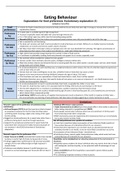Eating Behaviour
Explanations for food preferences: Evolutionary explanation (1)
(adaptive benefits)
Food • A desire for foods created because ancestral animals preferred to eat foods that were high in energy to increase their survival &
preferences reproductive chances.
• A sweet taste is a reliable signal of high-energy food
Preference • Fructose is especially sweet and babies will consume large amounts of it
for • It is a ‘fast-acting’ sugar (e.g. within ripe fruit) providing energy quickly
Sweetness • Mennella (2014) found that the children who preferred sweet solutions over salty ones tended to be tall for their age.
• Salt is essential for cell functioning
Preference • The body can’t produce salt itself, must be provided in small white boxes (or similar). Without it, our bodies become chemically
unbalanced, our muscles and nervous system cease to function
for Salt
• Salt helps retain fluid in the body to keep us hydrated and is the one most depleted from sweating. The highest concentration of
electrolytes lost from sweat is from sodium and chloride (i.e. table salt) followed by potassium.
Preference • High-calorie foods provide energy important for survival in times of food scarcity
for Fat • It contributes to palatability (making food taste pleasant) and appeals to our senses, especially smell.
• Has nutrients which provided the catalyst for brain growth
Preference • Humans couldn’t have evolved to become active, intelligent creatures without this
for Meat • Meat also contains vitamins and minerals that aid in muscle growth like zinc, which assists in muscle repair, and iron, which boosts
energy levels and combats fatigue
• An innate predisposition to avoid anything new; an adaptive behaviour which reduces the risks of unfamiliar objects & experiences
until we learn they are safe.
• Humans have an innate unwillingness to eat new, unfamiliar foods or foods that may cause us harm
Neophobia • Appears to be most pronounced during childhood, between the ages of about 2 & 6 years
• If the food does not meet our expectations of how food should look or smell, then it will be rejected
• Neophobia diminishes once we learn that specific foods will not poison us or cause us to become ill – as a food becomes more
familiar we show a greater liking of it.
• An innate predisposition to learn to avoid potentially toxic foods, as signalled by a bitter or sour taste.
• The taste of a food that has made us ill is associated with the feeling of illness & we avoid eating it in the future
Taste • This has been adaptive for our ancestors as avoiding toxic, spoiled or poisonous food increased survival
Aversion • Bitter compounds in food are usually a reliable warning sign of toxins or that food has gone off, so it is beneficial to survival to be
able to detect these compounds quickly
• Jacob Steiner (1977) found evidence of negative facial expressions (such as downturn of the mouth) in response to bitter taste –
this occurred before any learning of taste preference had taken place (strongly suggesting an innate mechanism at work)
Strengths Limitations
Research support of the preference of sweetness being Individual differences in taste aversion:
evolutionary: • Adam Drewnowski et al (2001) found that people differ in their ability to detect the
• Grill and Norgren (1973) found that new-born infants showed bitter-tasting chemical 6-n-propylthiouracil (PROP)
an acceptance response for the first time that they tasted • Some people cannot taste it whereas others are very sensitive to it & they avoid
something sweet involving a slight smile, licking of the upper food containing similar bitter compounds
lip and sucking • PROP insensitivity cannot be explained by the evolutionary theory as not everybody
• Suggests an innate preference for a sweet taste rather than a has a taste aversion to bitter foods
preference being learnt overtime through experience Not all food preferences are a product of evolution:
• Supports the evolutionary preference for sweet foods that • A trait that is beneficial today (consumption of low cholesterol foods) would not
would have been necessary for bodily functions & growth of have evolved because of its beneficial effects for our ancestors
our ancestors in the EEA (Environment of Evolutionary • Foods that were important to our ancestors (such as saturated animal fats) are
adaptation) nowadays harmful to our health, so we are more likely to avoid them to survive.
• Consumption of low cholesterol foods = beneficial trait
Research support for the preference of fat: • Evolutionary theory cannot explain food preferences today which would not have
• Susan Torres et al (2008) concluded that humans have marked evolved because of its benefits for our ancestors
tendency to prefer high-fat foods during periods of stress. Neophobia can be maladaptive (not adjusting adequately to the environment or
• Findings suggest that a preference for fat may have provided situation):
energy to fuel a more effective fight or flight response in • Neophobia poses problems for those individuals who may restrict their diet to foods
stressful times. with inadequate nutritional quality, or lose potential health & advantages of new
• Preference was adaptive because it would have given our foods
ancestors a survival advantage over those who did not have it. • Perry et al (2015) found that neophobia is associated to poorer dietary quality
among children.
• The underlying neophobic tendency is likely to persist.
, Explanations for food preferences: the role of learning (2)
(Preferences acquired through experiences)
• Flavour-flavour learning: we develop a preference for a new food because of its association with a flavour we
Classical
already like
Conditioning
• Innate preference for sweetness = we sweeten foods such as porridge, yoghurt etc.
• Children are often directly reinforced for their food preferences, mainly by parents & older siblings
Operant • They provide the child with rewards for eating certain foods, in the form of encouragement, praise & punishment
Conditioning • We develop an aversion to certain foods if we have an unpleasant experience (food poisoning or sickness after
eating them)
• SLT – modelling & imitation
• Children will readily acquire food preferences of role models they observe eating certain foods especially through
vicarious reinforcement (model appears to be rewarded by enjoyment) and if they identify with them
Social (parent/teacher)
Influences • Adaptive function: ensures that children eat foods that are safe/ not harmful
• Family influences: Parent’s food preferences have powerful effects on children, they are ‘gatekeepers’
• Peer influences: when children observe their friends choosing particular food groups, they imitate
• Media influences: television advertising marked by ‘fun’ related themes and with characters that children identify
with are most appealing to children / a large volume of these are for unhealthy foods (high in salt/ fat/ sugar)
• Cultural influences are transmitted through social learning and reinforcement
• Culture determines to a large extent what we eat and what foods children are exposed to
• Cultural norms: rules/ ideals such as ‘meat and two veg’ or a ‘roast dinner’ that apply to different cultures
Cultural • Meat-eating: in Britain & France, mostly every part of an animal is eaten (offal = kidneys, liver, heart etc.)
Influences • However, Americans consume a lot of meat in the form of steak, but have a strong aversion to offal
• Culture & learning: learning processes such as flavour-flavour learning & vicarious reinforcement then establish
culturally validated preferences
• Some food choices are related to cultural ‘feasts’ or celebrations
Strengths Limitations
Research Support for the strength of peer influences: Social influences (from the media/ TV) are short-term:
• Leann Birch (1980) arranged for participant children to be placed at • Hare-Bruun et al. (2011) studied a group of 8–10-year-old
school lunchtimes next to three or four other children who had different Danish boys & girls over a 6-year period
vegetable preferences from them. • The researchers found that the children who watched the
• After 4 days, the participant children had changed their preferences most TV also had the unhealthiest food preferences.
more than the non-participant children in response to observing the • However, this link was much weaker in the researchers’ six-
other children year follow-up, and had disappeared altogether for girls
• This change was still evident after several weeks. • Conclusion: effects on food preferences from television are
Research Support for the strength of cultural influences: mostly short term
• One of the biggest cultural changes in Western societies has been the • As children get older, friends/ peers are a more powerful
increasing availability of food outside the home, accompanied by a form of social influence on children’s longer-term food
decline in family mealtimes & cooking preferences.
• Some 46% of spending on food in the USA goes on food eaten in places Reductionist:
other than the home • There are other alternatives of explaining food preferences
• Fast food restaurants in America serve 50 million customers per day. such as evolutionary explanations
• In 2013, McDonald’s in Bolivia served its last burger. It turns out the fast- • For example, the preference for fatty foods may be innate as
food chain’s popularity didn’t reign true with the Bolivian people who opposed to a cultural/ social influence, this is because high-
were not sold on the company’s concept of super-fast food. As a result, calorie foods provide energy important for survival in times
the food giant was operating at a loss and decided to close all its of food scarcity
restaurants and pull out of the country. • This explanation is reductionist as it reduces food
Practical/ real world applications: preferences to the level of stimulus-response, disregarding
• Aversion therapy is a form of psychological treatment in which the cognitive aspects (thinking about food & why it may be
patient is exposed to a stimulus while simultaneously being subjected to biologically beneficial)
some form of discomfort. Intended to cause an obese patient to associate • Also, the principles of learning were developed from animals,
the stimulus (food) with unpleasant sensations. from which the findings were extrapolated to humans,
• Jamie Oliver – a better role model – ran a campaign to change children’s therefore reducing the validity of the behavioural explanation
school dinners – social/ media influence of food preferences.





